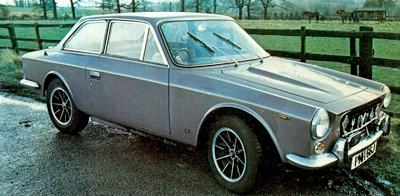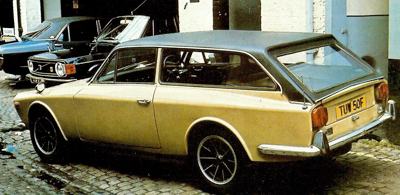Bernard Friese and Giles Smith
Gilbern has the distinction of being the only motor manufacturer that has ever made complete cars in Wales. The company came into being when a German ex-prisoner of war, Bernard Friese, began working for a company which specialised in the use of glassfibre. He decided to build himself a car using glassfibre
bodywork and, when this special was finished, it caught the attention of Giles Smith, who ran a butchery business in Llantwit Fardre near Pontypridd, Glamorgan.
The two men joined together to build a modified version of the original car in a workshop behind the butcher's shop and in
1959 they decided to go into production with the car, setting up in a small factory in Llantwit Fardre. It was decided to call the new car Gilbern simply by using the first parts of the two men's Christian names. The first car, the Gilbem GT Mk I, was a two-plus-two, two-door coupe largely using BMC components. The car featured a steel-tube chassis with large diameter side members and built up sections at the front to take the BMC double-wishbone front suspension, and at the rear to hold the mountings for the BMC live rear axle which was mounted on coil-spring/damper units and located by radius arms.
Braking was by 9 inch front discs and 8 inch rear drums, steering being by BMC rack-and-pinion. Originally, three choices of engine were offered to customers; a BMC A series 948cc unit fitted with a Shorrocks supercharger, a Coventry Climax 1098cc single-overhead-camshaft racing engine and the 1558cc BMC engine as fitted to the MGA. The super-charged engine proved temperamental and the Coventry Climax engine never caught on, so the only unit sold in any numbers was the MGA unit which gave the car a top speed of 100 mph and very brisk acceleration by the standards of the day.
The glass-fibre body was rather ugly and not very well finished on early examples, but improvements to the moulds were made and in their first year, eleven cars were built. The cars were usually sold as kits of parts but Gilbern trimmed the body completely so that owners merely had to bolt on the suspension and drop in the engine/ gearbox unit. In kit form, the Mk I sold in the UK for £978. By
1962, the 1622cc MGA engine had been substituted for the smaller unit and production was running at a comfortable one car a week.
The Gilbem 1800 GT
Various improvements had been made, a small dealer network set up, and the car was beginning to become well known in specialist motoring circles. The 1622cc version carried on to the end of
1963 but this was then superseded by the 1798cc MGB-engined car, and the model was renamed the Gilbem 1800 GT. Various improvements were made to the car including the addition of a Panhard rod for improved location of the rear axle and the option of Laycock de-Normanville overdrive as used on the MGB. The top speed had now risen to 110 mph. The Gilbern was carving itself an increasing share of the GT market, its combination of four seats and good acceleration allied to a modest price more than making up for the rather dated styling.
The Gilbern Genie
By
1965 production was up to three cars a week, still mostly sold in kit form. In
1966, it was decided to build a completely new model, the Genie, which featured a new body and mechanical components taken from Ford and BMC models. The car still retained a square-tube space-frame-type chassis with double wishbone and coil-spring front suspension combined with an MGB live rear axle located by radius arms and a Panhard rod suspended on coil springs and telescopic dampers. The engine chosen for the new model was the Ford Zodiac V6 unit; with a capacity of 2994cc, this engine produced a useful 144 bhp at 4750 rpm.
The engine was mated to the four-speed Ford gearbox. The steering was once again the MGB rack-and-pinion unit and braking was by MGB-10 inch discs on the front wheels in conjunction with 10 inch rear drums.
To overcome some of the inherent weaknesses of glass-fibre bodywork, the doors were hung directly on the chassis frame so that they would not drop in service. The glassfibre body was a great improvement on its predecessor, the new shape being a stylish slab-sided two-door coupe. Single headlamps were recessed into the wings and a full width grille was fitted. The main problem with the body was the large flat areas along the sides, as Gilbern found it impossible to eliminate the slight ripples in the surface finish. This problem stayed with the car to the end.
 1971 Gilbern Invader. It looked a lot like the earlier Genie, but was fitted with revised suspension that made the handling far superior to its predecessors.
1971 Gilbern Invader. It looked a lot like the earlier Genie, but was fitted with revised suspension that made the handling far superior to its predecessors.
 Gilbern Wagon version.
Gilbern Wagon version. |
The only other major problem with the car was in the steering geometry which tended to allow the steering wheel to go 'over centre' when cornering hard. This disconcerting tendency was gradually eliminated by changes to the suspension. The top speed of the Genie was a healthy 120 mph with a 0-60 mph acceleration time of around 9 seconds. Since the rear seats offered more leg room than those of its predecessor, the car found a steady if not booming demand, and again most cars were sold in kit form, although a completely built up car could be purchased.
Ace Holdings
Sales were not as promising as those of the old Mk I model, partly as a result of a price increase and partly because of increased competition. An injection of capital would obviously assist in financing further expansion so, in April
1968, the company was acquired by Ace Holdings Ltd of Cardiff, who themselves were shortly taken over by Mecca, the dance-hall and leisure group.
Bernard Friese and Giles Smith remained as directors, charged with the task of increasing the dealer network and boosting production from a modest two cars a week to five or more. In late
1968, an additional version of the Genie was announced; this was basically the standard model fitted with Tecalemit Jackson fuel injection which boosted the power output to 165 bhp. The car was named the PI 130 (for petrol injection and the claimed top speed) but it found few takers.
The Gilbern Invader
The Genie continued in production until 1970 when it was replaced by the Invader, which was essentially the same car. The
bodywork was virtually unchanged apart from improved door handles, but light-
alloy wheels were now available, automatic transmission became an optional extra, the interior trim was improved and the front disc
brakes were increased in diameter to 11.25 inches. For
1971, an wagon-car version of the Invader was announced. This was very similar to the sedan model in specification except that the roof line was carried further rearwards, and an opening tailgate fitted.
Sales began a gradual decline in
1972 largely because mass-produced cars like the
Ford Capri and MGB GT could be obtained much cheaper. Further problems were presented to the company with the introduction of VAT in April 1973, which virtually killed kit-car manufacture. Gilbern anticipated the ending of kit-car making and stopped building kits late in 1972, but the price of the sedan escalated dramatically the Gilbern now being almost as expensive as cars like the Jaguar XJ6. It came as no surprise that demand for the Gilbern slumped considerably. Another costly problem for Gilbern was the new safety and pollution laws which required them to crash test a car and satisfy
exhaust pollution tests.
Gilbern were able to gain a temporary exemption but sales would not support this costly undertaking and production ground to a halt in mid
1973. A Welsh property developer and financier read about Gilbern's troubles and negotiated a takeover bid. He quickly put the car back into production but the price increased even further - this in itself was enough to sound the death knell of Gilbern but it was the Arab/Israeli war and the subsequent rise in petrol prices and drop in car sales that finally ended the life of Wales' only car maker.



